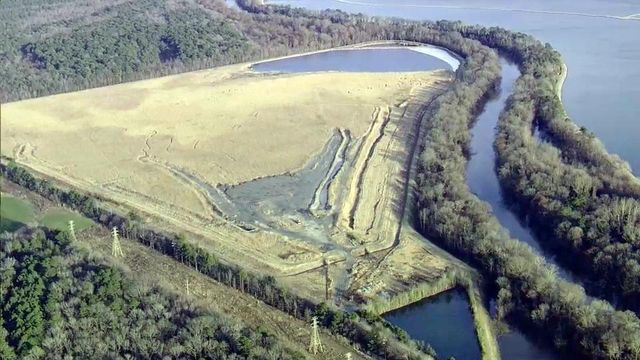Duke to dump more ash in Chatham, Lee pits
Duke Energy said Tuesday that it plans to move coal ash from another 12 unlined pits at its North Carolina power plants to lined landfills, primarily clay mines in Chatham and Lee counties.
Posted — UpdatedState regulators recently issued the necessary permits for Duke to dump coal ash in the open-pit mines as "engineered structural fill."
“We’re making strong progress to protect groundwater and close ash basins, delivering on our commitment to safe, sustainable, long-term solutions,” Duke President and Chief Executive Lynn Good said in a statement.
The utility plans to excavate five basins each at the Cape Fear Plant in Moncure and the H.F. Lee Plant in Goldsboro and one basin each at the W.H. Weatherspoon Plant in Lumberton and the Cliffside Steam Station in Mooresboro. More than 13 million tons of ash from Moncure, Goldsboro and Lumberton will be dumped in the clay mines, while 423,600 tons of ash from Mooresboro will be shifted to a lined landfill at the plant site.
Coal ash is the material left after coal is burned for fuel. While the bulk of it is inert, it does contain heavy metals and other toxins, including arsenic, chromium, selenium and mercury, that can harm fish, wildlife and people.
Despite containing those toxins, coal ash has been stored in unlined storage ponds for decades by Duke and other North Carolina power generators. Those ponds are perched along the same waterways from which the utilities have drawn water for their steam stations – and from which millions of North Carolinians draw their drinking water.
After a ruptured stormwater line under an ash pit in Eden dumped tons of sludge into the Dan River last year, North Carolina lawmakers ordered Duke to close all of its ash pits statewide by 2029 and created a state commission to oversee the process.
Good said Duke assembled a group of engineers and scientists to help recommend how to handle ash at various sites. For example, the company is building lined landfills at plants in Eden and Wilmington to handle ash from those plants, and it is moving ash from its Asheville plant to a "structural fill" project at the local airport.
Other ash from Wilmington and a Mount Holly plant is already being moved to the clay mines in Moncure and Sanford. Formerly used by brick manufacturers, the mines have layers of impervious clay that add environmental protections to the synthetic liner Duke plans to install, officials have said.
“While conditions at each site are unique, our board has established a common set of principles for Duke Energy to apply to each closure option, ensuring compliance with state and federal laws,” said John Daniels, chairman of Duke's coal ash advisory board, said in a statement. “We fully support this science- and engineering-based approach.”
Daniels is a former program director at the U.S. National Science Foundation and is a professor and chairman of the Department of Civil and Environmental Engineering at the University of North Carolina at Charlotte.
Duke is studying the remaining 12 as ponds in North Carolina to identify how best to close those facilities with minimal environmental impact. Officials said that, based on engineering work completed to date, the ash could be capped with a durable liner and left in place.
“We’re very pleased that Duke Energy has now committed to a full cleanup at half of its sites, but we’re also disappointed that this $50-billion company isn’t making the same commitment for the other seven plants in North Carolina,” Waterkeeper Alliance attorney Peter Harrison said in a statement. “We’re especially concerned that Duke hasn’t agreed to remove the coal ash from the Buck plant near Salisbury and the Allen plant near Charlotte, where recent test found 97 percent of nearby drinking water wells contain dangerous levels of contaminants associated with coal ash."
• Credits
Copyright 2024 by Capitol Broadcasting Company. All rights reserved. This material may not be published, broadcast, rewritten or redistributed.






